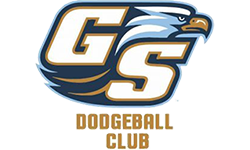Guide: Filming an NCDA Dodgeball Match
General Guidelines
- Capturing the most amount of action is the chief objective in filming a dodgeball match. Different angles and greater work in production can increase the amount of action in the final cut of the video.
- Where ever the cameras are placed, they should be on the same sideline. This establishes a constant reference point for the audience, and helps them keep track of the action.
- The goal is to record the entire duration of the match, from start to finish. Recording about 2 minutes of cleanup after the conclusion may allow for a recap in post production, but is not necessary.
- To be safe for one recorded game, you’ll need to allow for 1.5 hours of HD recording, if the cameras are set up to run for the entire match. While a match is 50 minutes of game time, actual duration ends up being longer with timeouts, violations, point setup, etc.
This means making sure the batteries have enough charge to run for this time time, and that there is enough memory to capture the required film. Make sure the batteries are fully charged. If available, bring a camera that can plug into an AC adapter and still record. Don’t forget the extension cord!
- In general, placing cameras at higher angles captures more action, and keeps spectators and officials out of the shot more often. If you can get a camera on a track above, or even at the top of the stands, it can be very beneficial.
- Protect your camera! If someone can’t stand with a camera, place a piece of equipment like a chair or mat in front of the camera. Make sure your view isn’t obstructed by the equipment. Your cameras will strangely attract more errant throws, so protecting them is important.
- For tournaments, make sure your camera has as much storage as possible. As the camera storage fills up, you’ll need a place to dump footage. Bring a laptop and/or an external hard drive. File transfers take time, so another camera will need to be ready to go so the film crew doesn’t miss any of the action.
- The League YouTube has a high video duration upload limit. Filmed Matches can be uploaded in their entirety, which is preferred over point by point uploads. Contact the League email if you want to arrange uploading a Match to the League YouTube.
Types of Cameras & High Definition
High Definition cameras are important because they help see more of the action, and dodgeball has much more action than other sports. Cameras with high frame rates are especially helpful in tracking the very common high velocity throws, or allowing slow motion replays in post.
High definition video in 1080p is very helpful in showing the entire action involved in the game. Expanding on that, if technically available, recording in a ultra high definition video can be helpful in post production. Editors can zoom in on a particular area of the shot, or highlight editors can focus on a smaller area and still retain good picture quality.
Gopros and wearable cameras can create cool footage. It might be a plus if this footage can be spliced with footage from the Match, using other establishing shots.
Various Camera Placements
- Halfcourt Center Aerial: One camera placed very high above and at center Halfcourt, looking down on the entirety of the Court to give a view from Baseline to Baseline. Some constraints or celing heights might require a fisheye lens. IF THIS IS POSSIBLE, BY ALL MEANS MAKE IT HAPPEN. Can be used as a stand alone or in a multi-angle setup for establishing shots.
- Halfcourt Neutral Zone Closeup: One camera close on the Neutral Zone at Halfcourt, just above head level to peer over the Officials, with the closer part of the Attack Line vanishing into the bottom of the shot. Usually used in a multi-angle mechanic.
- Halfcourt Neutral Zone Pivot: One camera placed at Halfcourt, which can cover the Netural Zone by default, but may have a camera operator panning the camera to either teams side, in order to capture the back and forth action of the Match. Can be used as a standalone, but useful in a multi-angle mechanic.
- Halfcourt Establishing: One camera placed at Halfcourt, far enough back to get most of the Court in view, from Baseline to Baseline. The higher the better. Can be used as a standalone camera, using minimal post production.
- Center Baseline High: Sometimes used when neither the Corner or Halfcourt are available. This is useful for capturing one team’s action, but must be placed very high in order to protect the camera from direct throws. Can be used in a multi-angle mechanic.
- Corner High Baseline: One camera is set from one corner, usually paired with another camera in the opposite corner on the same Sideline. In order to more efficiently capture the most action of the Match, they should be set up as high as possible. They tend to be more able to focus on more Baseline, as opposed to the Sideline. Useful for post production editing by switching angles to follow the action.
- Corner Level Sideline: One camera set from one corner, angled to show more of the sideline. Tends to capture less action than other positions and action might be obstructed by players on the Baseline.
- Corner High Establishing: One camera set from one corner, as high as possible and focused on most of the Court. Usually used as a standalone camera, using minimal post production.
- Attack Line Level: Two cameras on the same Sideline that are placed on or near the Attack Lines. Because of the more head level angle, focus tends to be towards the closest Baseline and focusing on Targets more than Throwers. Useful in a multi-angle mechanic, and capture more action the further they are placed from the Sideline.
- Attack Line High: Two cameras on the same Sideline that are placed on or near the Attack Lines. A high angle allows some throws at the Attack Line to be captured, while also allowing some of their Targets to be in the shot. View may be towards the cameras closest Baseline, or the view may be towards the opposite Baseline, forming a crisscross pattern of sight lines.
- Attack Line High Cross Shot: Two cameras on the same Sideline that are placed on or near the Attack Lines. Forms a crisscross sight line, where the right camera focuses on the left Baseline, and the left camera focuses on the right Baseline.
Three+ Camera Mechanics
[Written up soon -zm]
Two Camera Mechanics
A very simple way to capture most of the action of a dodgeball match involves setting up two cameras, each covering a different part of the court. There are a few different cameras positions that can be combined to great affect in post production.
Two Attack Line
A two camera mechanic, with both cameras on the same Sideline, generally set to run for the entire Match.
- Attack Line Level: Focus tends to be towards the closest Baseline and focusing on Targets more than Throwers. The further back from the Sideline, the more action can be captured, but focus on individual actions is not available.
- Attack Line High Same Baseline: A high angle allows some throws at the Attack Line to be captured, while also allowing some of their Targets to be in the shot. View is focused on the camera’s closest Baseline.
- Attack Line High Cross Shot: Forms a crisscross sight line, where the right camera focuses on the left Baseline, and the left camera focuses on the right Baseline.
Two Sideline Corners
A two camera mechanic, with both cameras on the same Sideline, generally set to run for the entire Match.
- Corner High Establishing: The shot can show most of the Court, with switching angles in post to capture the action.
- Corner High Baseline: The edge of the shot should show as much of its Baseline as possible, but also show some of the closest Sideline. This is a balancing act that gets easier the higher the cameras are above head level.
Two Halfcourt, Neutral Zone & Establishing
Nationals 2011 Championship at WKU’s Preston Center, editing by Aleks Bomis & Josh Raymer, filmed by WKU Dodgeball, commentated by AJP hosts Zac Newton & Alex Heichelbech.
Used a two camera mechanic, with both cameras on the same Sideline. Cameras were set to record the entire match, and did not
- Neutral Zone Closeup: one camera close on the Neutral Zone at Halfcourt, just above head level, with the closer part of the Attack Line vanishing into the bottom of the shot. Allows a closer view of what’s happening at the Attack Lines.
- Halfcourt Establishing: one camera at Halfcourt, at the second story on the track above, further back to establish a wide shot of the entire court.
Post Production: Footage was switched between these two shots. An additional camera was placed up high on the track, to the right side of the Sideline, but wasn’t used as much as the Halfcourt Establishing. The Halfcourt Establishing took care of most of the work in recording the action of the match.
One Camera Mechanics
Sometimes the simplest approach still satisfies. One camera is better than no video of the Match. There are a few different camera placement approaches. Any establishing shot allows for easy “turn it on and forget it” usability.
- Halfcourt Establishing: Very useful if the camera is placed high enough and far enough back in order to get both baselines in view.
- Halfcourt Netural Zone Pivot: Useful if you don’t have the space, but have camera operators available.
- Corner High Establishing: Useful at the top of the stands or on the running track, if the Halfcourt Establishing is obstructed.
- Corner Level Sideline: Better than nothing, the shot should be set up to capture the most amount of area available. Be sure to protect the camera from stray throws.
Credits: Zigmas Maloni, Josh Raymer

























